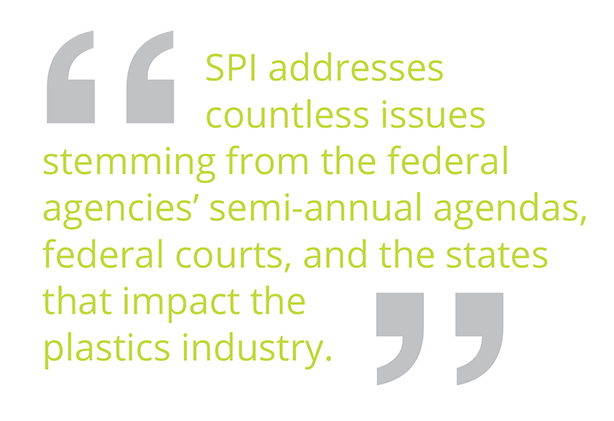Five Regulatory Issues to Watch in 2016
Previous Article Next Article
Five Regulatory Issues to Watch in 2016
Previous Article Next Article
Five Regulatory Issues to Watch in 2016
Previous Article Next Article

This year is proving to be packed with regulatory activity at the federal level for two big reasons: first, with Congress focused on elections, federal agencies may face less scrutiny than in any other year, and second, this is President Obama’s last opportunity to make lasting policy changes. Stateside, not surprisingly, California will remain active from a regulatory standpoint this year as well
SPI addresses countless issues stemming from the federal agencies’ semi-annual agendas, federal courts, and the states that impact the plastics industry. Here are five.
Foreign Supplier Verification Programs (FSVP)
The Food and Drug Administration (FDA) issued its final FSVP rule in November 2015 under the Food Safety Modernization Act (FSMA). FSVP governs food that is imported to the United States and ensures that those importing food are doing so in a manner that is as safe as possible for the American public.
SPI worked with FDA to ensure that the rule would include an explicit exemption for food-contact substances, but unfortunately the final rule did not provide any such exemption. By default, this means the rule encompasses food packaging. SPI members could be subject to onerous and unnecessary requirements to conduct food safety hazard assessments and audits of their foreign suppliers if they manufacture food-contact substances. SPI is currently working with FDA on the issue and hopes to see some clarifying action by the agency in 2016.
Improve Tracking of Workplace Injuries and Illnesses
The pending Improve Tracking of Workplace Injuries and Illnesses rule is one of the Occupational Safety and Health Administration’s (OSHA) highest priorities. A final rule is under review at the Office of Management and Budget’s Office of Information and Regulatory Affairs.
SPI submitted comments on the November 2013 proposal, which would require the electronic transmission (annual or quarterly, depending on the number of employees) of information that is currently recorded, but not reported, to OSHA or its designee. Significant concerns include maintaining employee confidentiality, particularly in terms of posting information on a public website, as well as employer and agency resource burdens.
Combustible Dust
OSHA does not have a comprehensive standard to address combustible dust, though it is now in the definition of “hazardous chemical” in the Hazard Communication Standard (HCS). Combustible dust incidents have resulted in fires and explosions, and rulemaking activity was first published in the Unified Agenda in spring 2009. The next step is seeking small business input, required under the Small Business Regulatory Enforcement Fairness Act (SBREFA), but there are continuous delays.
SPI will monitor OSHA’s progress. SPI is also watching combustible dust activity under the Globally Harmonized System of Classification and Labelling of Chemicals and comments on National Fire Protection Association standards 654 and 652. SPI is currently developing comments for the revision of NPFA 652, due June 29.
Risk Management Plan Rule
The U.S. EPA began the rulemaking process for revisions to the Risk Management Plan (RMP) Rule with a Request for Information (RFI) in 2014. RMP requires facilities that meet threshold quantity requirements of specific regulated substances to develop plans in case there is an accidental release.
After the SBREFA process, EPA released a proposed rule in February 2016. SPI will file comments. OSHA is now convening a SBREFA panel for potential revisions to the Process Safety Management of Highly Hazardous Chemicals standard, for which OSHA issued an RFI in December 2013. SPI will continue monitoring.
California’s “75% Initiative”—The Manufacturers’ Challenge
In 2011 California passed legislation that sets a non-mandatory target of reducing the amount of solid waste sent to landfills by 75% through reduction, recycling, or composting by 2020. The “75% Initiative,” as it’s referred to, is being implemented by CalRecycle, the state agency that handles recycling and recovery efforts.
The Manufacturers’ Challenge is a program that targets packaging materials and sets a goal to reduce the amount of packaging sent to landfills by 50% by 2020. SPI has submitted comments and met with CalRecycle, and also participated in the Manufacturers’ Challenge meeting, which took place on January 5, 2016. More updates on the initiative and CalRecycle’s outreach efforts to manufacturers could occur in 2016, and SPI will keep the plastics industry informed.
See more about SPI’s policy initiatives at www.plasticsindustry.org/PublicPolicy.